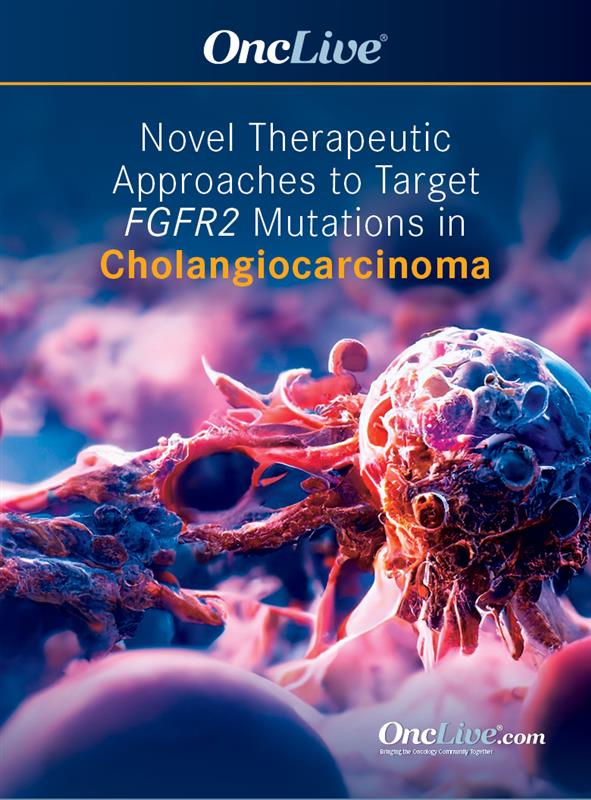Publication
Video
Supplements and Featured Publications
Dr Borad on the Initial Efficacy of RLY-4008 in FGFR2 Fusion–Positive Cholangiocarcinoma
Author(s):
Mitesh Borad, MD, key findings from the phase 1/2 ReFocus trial in FGFR2-altered cholangiocarcinoma.
Mitesh J. Borad, MD, oncologist, Department of Medical Oncology, Mayo Clinic Comprehensive Cancer Center, discusses key findings from the phase 1/2 ReFocus trial (NCT04526106) in FGFR2-altered cholangiocarcinoma.
The ReFocus trial evaluated the novel FGFR2 inhibitor RLY-4008 in patients with FGFR2-altered solid tumors. Within the cholangiocarcinoma cohort, patients were either FGFR inhibitor naïve or FGFR inhibitor refractory. The phase 1 portion aimed to determine the recommended phase 2 dose (RP2D) and proof of mechanism of RLY-4008, as well as the agent’s safety, pharmacokinetics, pharmacodynamics, and initial efficacy. Efficacy data were reported for patients who received daily doses of less than 70 mg of RLY-4008 vs RLY-4008 at 70 mg or higher across all 3 of the dosing schedules, Borad states.
Preliminary results from the study showed that the 11 FGFR inhibitor–naïve patients with FGFR2 fusion–positive cholangiocarcinoma achieved an overall response rate (ORR) of 73% with 70 mg or more of RLY-4008, Borad reports. This included 8 partial responses (PR) and 3 patients with stable disease (SD). Responses were also shown to be durable, with a median duration of response (DOR) of 11.2 months, Borad adds. The 6-month progression-free survival and disease control rates (DCRs) were both 100%.
Conversely, the ORR in patients in this population who received less than 70 mg of RLY-4008 (n = 14) was 36%, Borad states. There were 5 PRs, 6 patients with SD, and 3 patients with progressive disease (PD). The median DOR in this population was 5.6 months, the 6-month PFS rate was 70%, and the DCR was 79%.
RLY-4008 also demonstrated clinical activity in patients with FGFR2 fusion–positive cholangiocarcinoma who were pretreated with FGFR inhibitors (n = 50), Borad notes. This difficult-to-treat population is known to experience poorer outcomes due to the development of resistance mechanisms and lack of effective therapeutics, he explains.
Patients in this population who received at least 70 mg of RLY-4008 (n = 14) experienced an ORR of 21%, with 3 PRs, 10 patients achieving SD, and 1 with PD, Borad continues. The median DOR was 5.6 months, the 6-month PFS rate was 43%, and the DCR was 93%. Individuals who received less than 70 mg of RLY-4008 (n = 36) had an ORR of 11%, including 4, 23, and 7 patients achieving PR, SD, or PD, respectively. Median DOR was 6 months; the 6-month PFS rate and DCR was 33% and 75%, respectively, Borad details.
Based on these data, 70 mg was selected as the RP2D, Borad says. The ongoing phase 2 dose expansion portion of the study will determine the agent’s efficacy in FGFR2-altered cholangiocarcinoma.
Disclosures: Dr Borad reports receiving research funding from Relay Therapeutics.
































%20(2)%201-Recovered-Recovered-Recovered-Recovered-Recovered-Recovered-Recovered-Recovered-Recovered-Recovered-Recovered-Recovered-Recovered-Recovered-Recovered-Recovered-Recovered.jpg?fit=crop&auto=format)
%20(2)%201-Recovered-Recovered-Recovered-Recovered-Recovered-Recovered-Recovered-Recovered-Recovered-Recovered-Recovered-Recovered-Recovered-Recovered-Recovered-Recovered-Recovered.jpg?fit=crop&auto=format)
